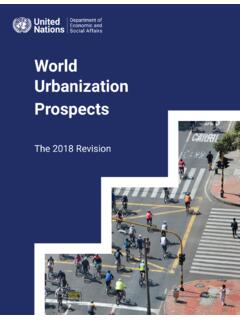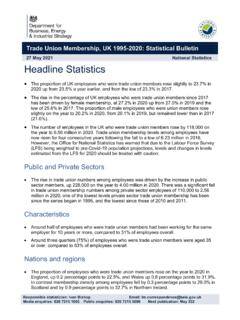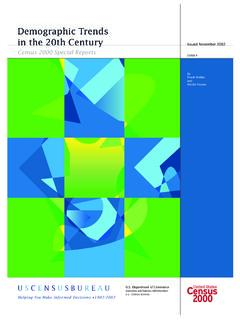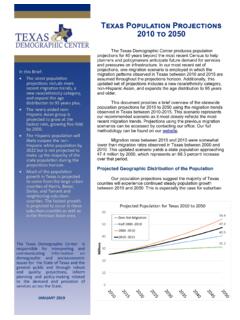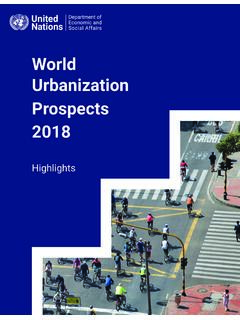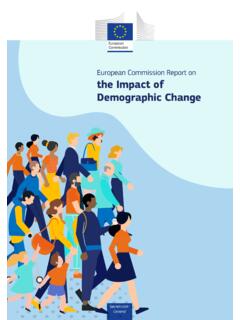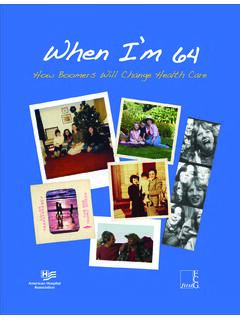Transcription of Centre for Population Annual Population Statement 2021
1 Population Statement Centre FOR Population December 2021 Centre for Population | i Commonwealth of Australia 2021 This publication is available for your use under a Creative Commons Attribution Australia licence, with the exception of the Commonwealth Coat of Arms, the Treasury logo, photographs, images, signatures and where otherwise stated. The full licence terms are available from Use of Treasury material under a Creative Commons Attribution Australia licence requires you to attribute the work (but not in any way that suggests that the Treasury endorses you or your use of the work). Treasury material used as supplied . Provided you have not modified or transformed Treasury material in any way including, for example, by changing the Treasury text; calculating percentage changes; graphing or charting data; or deriving new statistics from published Treasury statistics then Treasury prefers the following attribution: Source: Centre for Population 2021, Population Statement , The Australian Government, Canberra.
2 Derivative material If you have modified or transformed Treasury material, or derived new material from those of the Treasury in any way, then Treasury prefers the following attribution: Based on Centre for Population analysis / data. Use of the Coat of Arms The terms under which the Coat of Arms can be used are set out on the Department of the Prime Minister and Cabinet website (see ). Other uses Enquiries regarding this licence and any other use of this document are welcome at: Manager Media and Speeches Unit The Treasury Langton Crescent Parkes ACT 2600 Email: Centre for Population | ii CO N T E N T S From the Assistant Treasurer, Minister for Housing and Minister for Homelessness, Social and Community Housing .. 1 From the Executive Director of the Centre for Population .. 2 Summary .. 3 1. National Population .. 4 Summary .. 4 Net overseas migration.
3 6 Natural increase .. 10 2. State and territory populations .. 12 Summary .. 12 New South Wales .. 15 Victoria .. 16 Queensland .. 17 South Australia .. 18 Western Australia .. 19 Tasmania .. 20 Northern Territory .. 21 Australian Capital Territory .. 22 3. Capital city and rest-of-state populations .. 23 Summary .. 23 Net overseas migration .. 26 Net internal migration .. 27 Natural increase .. 30 4. Technical appendix .. 33 Forecast context and limitations .. 33 Natural increase .. 34 Net overseas migration .. 35 Net internal migration .. 36 Methodology .. 37 Natural increase .. 38 Net overseas migration .. 40 Net internal migration .. 40 Assumptions .. 41 Natural increase .. 42 Net overseas migration .. 44 Net internal migration .. 46 Comparing past projections to outcomes .. 48 Notes .. 52 Glossary .. 52 References.
4 55 Centre for Population | 1 FR O M T H E AS S I S T A N T TR E A S U R E R, MI N I S T E R F O R HO U S I N G A N D MI N I S T E R F O R HO M E L E S S N E S S, SO C I A L A N D CO M M U N I T Y HO U S I N G The Hon Michael Sukkar MP Assistant Treasurer, Minister for Housing and Minister for Homelessness, Social and Community Housing A detailed understanding of the size and distribution of our Population is fundamental to support economic and fiscal management and good policy making by all levels of government. The Population Statement outlines how the Australian Population has changed and details how we expect it to change in the future. The 2021 Statement analyses the extraordinary impact the COVID-19 pandemic continues to have on Australia s Population . Australia s Population has already recorded the slowest growth in over 100 years and growth is forecast to remain low at per cent in 2021-22.
5 This largely reflects the restrictions placed on international borders over this period. Overseas migration, which in recent years has been the main source of Australia s Population growth, is forecast to be a net outflow for the first time since just after World War II. The Statement also analyses the impact of the pandemic on internal migration as state governments temporarily closed domestic borders, locked down major cities and restricted travel in some regional areas. Interstate migration between states fell by 9 per cent nationally in 2019-20 compared to its peak in 2018-19. The Statement provides a sound and transparent evidence base that will assist decision making as Australia reopens and recovers from the pandemic. It will help us better understand changes in the distribution of the Population across the country, and provide a clearer picture of the infrastructure, housing and services that different communities need.
6 The Statement s analysis of long-term trends will help Australia prepare for demographic changes of an ageing Population over the decades ahead. Centre for Population | 2 FR O M T H E EX E C U T I V E DI R E C T O R O F T H E CE N T R E F O R PO P U L A T I O N Damien White Executive Director Centre for Population The Australian Government established the Centre for Population in 2019 to assess, monitor and project changes to the size and distribution of Australia s Population . The Population Statement is the Centre for Population s flagship Annual publication. It describes how Australia s Population has recently changed and projects future Population changes. This is the second edition of the Statement , building on the detailed historical analysis and projections in the 2020 Population Statement . The 2021 Statement looks at Population change over the past year and includes projections of the Population over the next decade.
7 It describes and analyses the role of the different drivers of Population change overseas migration, natural increase and internal migration. The analysis spans states and territories, capital cities and rest-of-state areas, age and gender. Over the course of 2021, the Centre has continued to enrich the Population evidence base with insights into the impacts of the COVID-19 pandemic. In this time we have commissioned and published research to better understand factors that drive internal migration, investigated sub-group mortality rates using microdata, and examined how the pause in overseas migration is affecting states, cities and regions. We continue to publish regular notes analysing Australian Bureau of Statistics data, including the relatively new Provisional regional internal migration estimates (PRIME) series, and Provisional Mortality Statistics. Responses by governments and individuals to the COVID-19 pandemic have resulted in nearly unprecedented effects on Australia s Population .
8 Consequently, it is difficult to confidently analyse recent Population trends and there is significant uncertainty around projections of future Population . The Centre has used its best professional judgement in its analysis, but, like everyone interested in demographics, will continue to watch as Australia progresses through 2022 and beyond. The release of National, state and territory Population for the 2021 June quarter will contain revisions to overseas and internal migration for the March 2021, December 2020 and September 2020 quarters. These revisions were not available in time to be taken into account in this Statement s projections. In preparing the 2021 Population Statement , the Centre has drawn on external input and expertise from academics and Population experts. The Statement has also been developed in consultation with the states, territories and the Australian Local Government Association.
9 I thank all those involved in its preparation. Centre for Population | 3 SU M M A R Y The 2021 Population Statement details the early impacts of the COVID-19 pandemic on Australia s Population and projects its impact over the next decade. These estimates were developed just as the Omicron variant was emerging in early December 2021 and prior to the release in mid-December 2021 of Australian Bureau of Statistics Population data for 2020-21. Part 1 of the Statement outlines detailed Population projections at the national level from 2020-21 to 2031-32. Australia s Population is estimated to have been million at 30 June 2020, and is projected to increase to million by 30 June 2032. Population growth over this period is forecast to increase from per cent in 2021-22 to per cent by 2024-25 before declining slightly to per cent by 2031-32. The size of the Population is expected to be around million people or per cent smaller by 2030-31 compared with what was projected in the MYEFO 2019-20, prior to the onset of the pandemic.
10 Overseas migration to Australia, which in recent years has been the largest contributor to Population growth, has been significantly affected by the COVID-19 pandemic. The introduction of international travel restrictions and quarantine arrangements has led to the first net overseas migration loss from Australia since just after World War II. Overseas migration is forecast to hit a low in 2020-21 with a net outflow of 100,000 people. As border restrictions and quarantine arrangements are relaxed, net overseas migration is forecast to recover to a smaller net outflow of 41,000 in 2021-22. It is then forecast to return to net inflows of 180,000 in 2022-23 and 213,000 in 2023-24 before returning to pre-COVID-19 trends of net inflows of 235,000 from 2024-25 onward. In contrast to the experience of other developed countries, COVID-19 has had minimal impact on Australia s births and deaths thus far.
